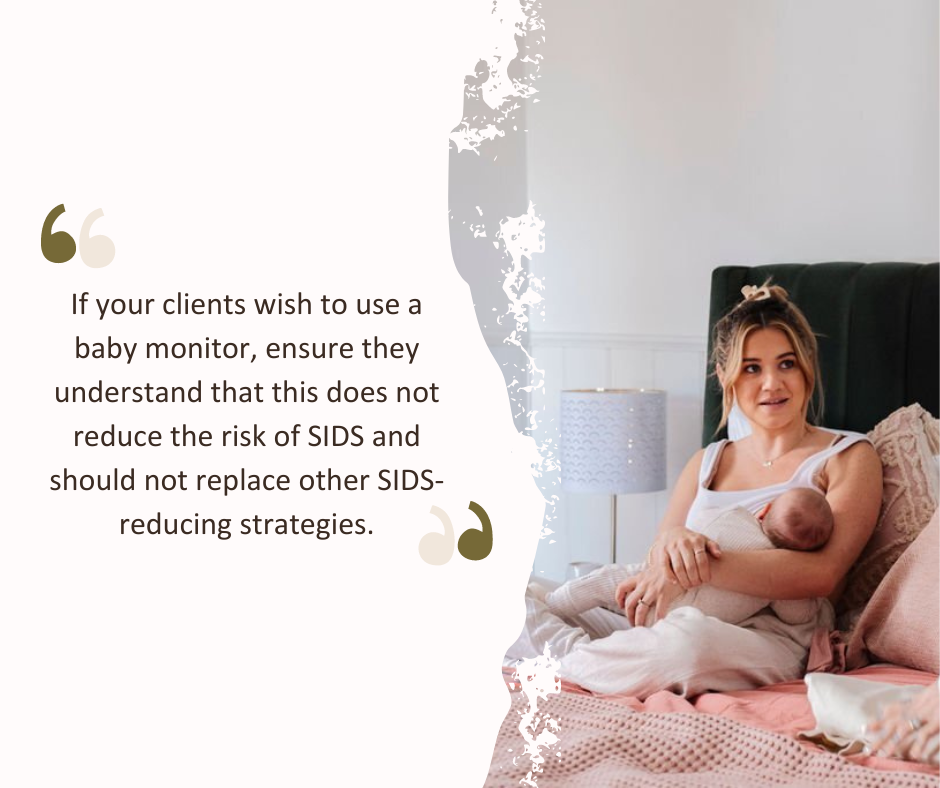Should I get a home monitor for my baby?
When I first started doing postpartum work, the most a baby monitor could do was let you hear your baby when you were in another room or hanging out the washing. Some parents found it reassuring to hear their baby when they were further away than usual. Audio monitors are straightforward and valuable if you live in a big house.
But now there are also video, movement, heart and breathing monitors. Things are getting pretty fancy and techy! As a result, many parents today wonder if they need all the bells and whistles.
The first place many parents get advice from is other parents. And when you ask at a parent group if you should get a fancy home monitor, there is likely to be someone in the room who says it gave them “peace of mind.”
This sounds reassuring, and peace of mind is wonderful to have as a parent. But when clients ask me about baby equipment, as a postpartum professional, I want to give information based on evidence.
Do home monitors save infant lives?
When it comes to safety, Red Nose is Australia's leading authority on safe sleep and pregnancy. Their research and education programs have prevented over 10,000 infant deaths—an extraordinary 85% reduction in SIDS deaths.
In their guidelines on home monitoring, Red Nose says, “monitors are not indicated for normal healthy babies and toddlers” and “there is no scientific evidence that using any type of monitor will prevent a sudden unexpected infant death.”
Some babies have even died while these monitors were in use. There are no safety standards for baby monitors in Australia, and there may be risks of strangulation or entrapment with monitors that have leads.
You can read more information here.
If you want to support your clients to reduce the risk of SIDS, there are six practical strategies Red Nose recommends:
Put baby to sleep on their back
Keep baby’s head and face uncovered
Keep baby smoke-free before and after birth
Provide a safe sleeping environment night and day
Sleep baby in a parent’s room for 6-12 months
Breastfeed baby
It’s possible that having a monitor may increase behaviours associated with an increased risk of SIDS. For example, the guidelines recommend room sharing for the first 6-12 months of a baby's life, but a monitor may give parents a false sense of security when a sleeping baby is in a separate room.
If your clients wish to use a baby monitor, ensure they understand that this does not reduce the risk of SIDS and should not replace other SIDS-reducing strategies.
What about peace of mind?
Having a baby is a big responsibility. For many parents, it's one of the scariest tasks they’ve ever undertaken. A little stress may make you pay careful attention to your baby’s cues and become a confident parent. However, it may take some time to get used to thinking constantly about your baby, but you can also see how it is an excellent survival strategy.
The question is, when does the healthy and normal stress of learning to be a good parent cross the line into anxiety, hypervigilance or controlling or obsessive thoughts that require some extra support from professionals?
If a parent you are working with is educated on real SIDS risks but is still feeling very worried, it may be appropriate to seek mental health support. Perinatal Anxiety & Depression Australia provides a great, free mental health checklist, which you can suggest your clients access on their website.
Reassure your clients that worrying a lot about your baby doesn’t mean they are doing anything wrong or are a bad parent; it just might mean they need a little extra support.
Monitors for deaf and hard-of-hearing parents
Very little information is available to Deaf and hard-of-hearing (DHH) parents, as most resources are directed at hearing parents raising DHH children. BUT DHH parents can benefit from home monitors that support them to respond to their baby’s crying, even when they can’t hear it. If you work with DHH parents, link them with local support groups and organisations and check what funding might be available to them for home monitors and other equipment and support they might need as DHH parents.
Having a postpartum professional supporting you in the weeks after birth can help you figure out what is healthy and safe for you and your family. Postpartum professionals provide evidence-based information about sleep, breastfeeding, and normal newborn development. They are also great listeners who can normalise your experience as a new parent and help reassure you when you’re feeling anxious or overwhelmed. Check out our directory here.


